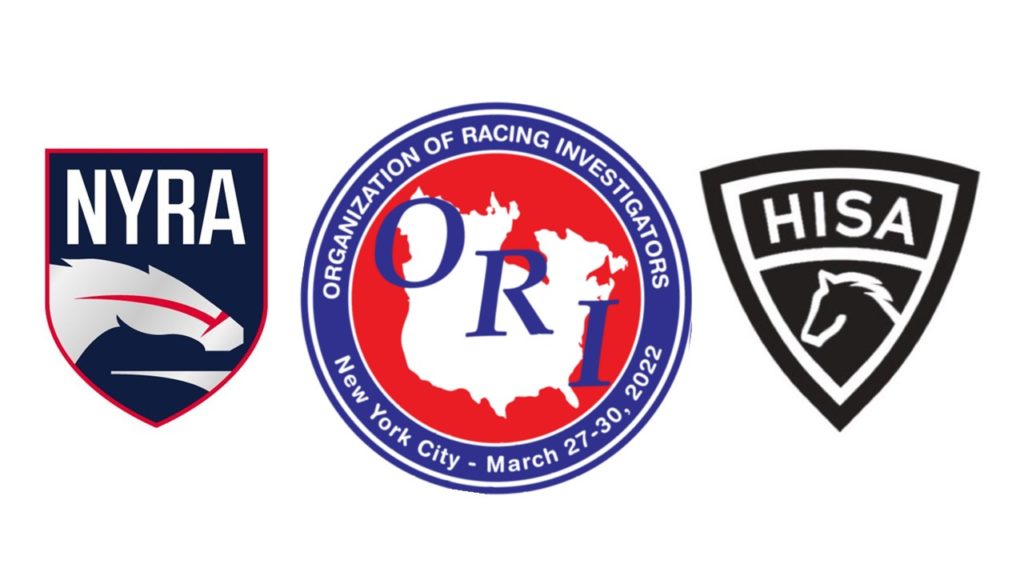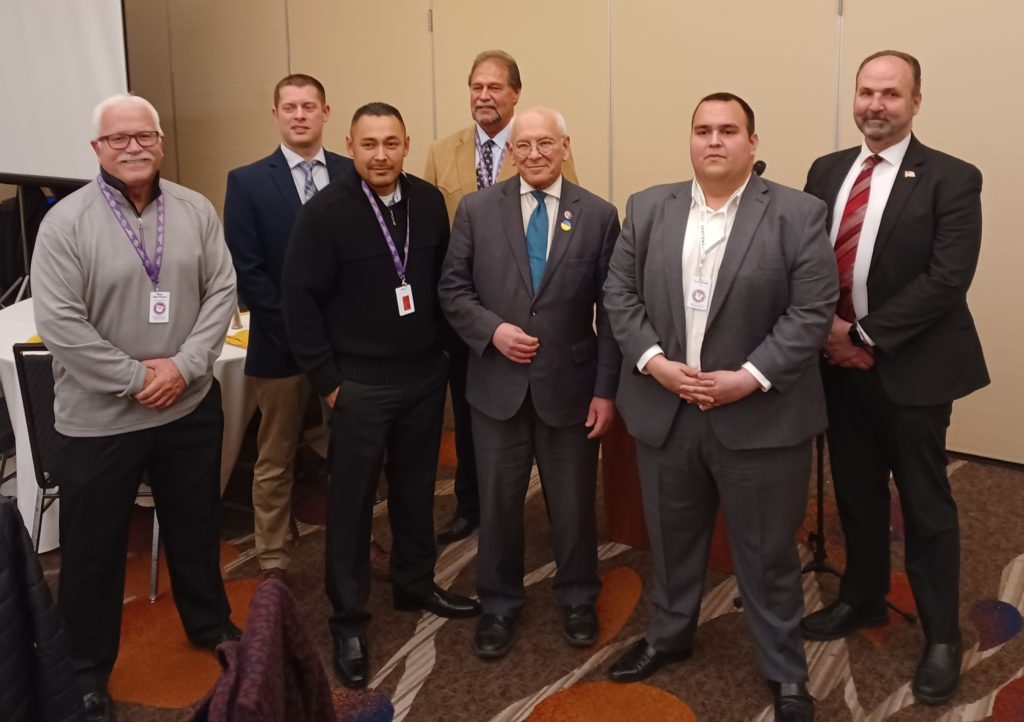
PRESS RELEASE – Hosted by the New York Racing Association (NYRA), Day 1 of presentations for the Annual Meeting of the Organization of Racing Investigators at Aqueduct Racetrack exited the gate on Monday. It was a brisk pace for all the entries … not only for those from the Empire State, but also for the shippers from Florida, Texas, California, Maryland, Canada, Ireland, and many other locales. A bevy of themes developed across a host of topics that included security operations at NYRA, the roles of stewards, pool manipulation, the differences between grey and illegal market betting, and the implementation of the Horseracing Integrity and Safety Act (HISA), which is now an “Authority.”
The day’s festivities began with a welcome and greeting by the dynamic Glen Kozak. As the Senior V.P. for Operations and Capital Projects for NYRA, he is one of the busiest individuals on the payroll. Managing the expansion of UBS Arena (which opened last November and is the home of the NHL’s NY Islanders), and the architectural environs around Belmont Park occupies a good bit of his purview. He set the tone for the day by discussing, “How the investigative services at NYRA work in concert with the Gaming Commission and the Jockey Club to promote safety and follow-up care for the equine athletes that are at the forefront of this industry.”
Moving on to the next stage of the ORI Agenda, the Senior Director of Security for NYRA, John Clyne, discussed how his past life as a police detective enlivened and fueled a career in racetrack security that, as he termed it, “Didn’t think was possible.” After witnessing firsthand such catastrophic events like 9/11, he filed away a set of skills that would be extremely useful to NYRA. The 106th Precinct includes Aqueduct, and incidentally, was famously John Gotti’s base of illegal operations. When NYPD Clyne was asked to join the security services at the track, he was reticent, to say the least. Once he relented, he was positioned on the frontside, witnessing every scam under the sun, to later, overseeing the entire complexes on the backside at Saratoga and Belmont. With over 1000 workers housed at those tracks, it continues to be a massive logistical undertaking in what has become a storied career.
After a break in the action, more NY-connected presenters took the stage, with NYRA Steward Brook Hawkins, and Jockey Club Steward, Dr. Jennifer Durenberger. They offered a refreshing 1-2 punch perspective concerning the critical role of “Relying on judgment, teamwork, and communication,” as Durenberger ably summarized it. Hawkins took the audience through their intricate process of watching a live race, and how seriously they take their trade. It is not a simple matter of posting results and standing by decisions. The spade work includes “educational outreach,” especially when it comes to younger apprentice jockeys. Explaining the importance of “riding all the way through the wire because there is a High 5 wager at stake for horseplayers,” is just one of the many “video sessions” they conduct throughout the Meet. The duo concluded with a discussion of how NYRA “House Rules” have evolved, especially with a state system that provided little guidance from the outset concerning day-to-day operations. NYRA has effectively used the “Violations Panel” to great effect, which includes a weekly meeting to handle infractions based on a “credential system.”
Shifting gears to examine how a corporate structure can support and promote protocols that deal with veterinary science, the esteemed Dr. Dionne Benson took to the podium. Her reputation as an equine medical professional is impressive, and she offered a progressive message about how 1/ST Racing is tackling everything from equine fatalities to overseeing data gathering during workouts. Her message not only gave specifics about shutting down horses before big race days, but also detailed intricacies like how the uproar over the use of the riding crop was overblown. Dr. Benson also outlined how smaller tracks could invest in basic data gathering systems that could bring about a tracking and tracing revolution. At Santa Anita and other Stronach ovals, she has instituted a “coding system” that helps address potential problems in horses before catastrophic breakdowns are even remotely possible. Random drug testing in training, along with having an increased veterinary presence during this time were just a few of the suggestions that have worked well during the past year. She also raised concerns about the future of veterinarians “going into the equine business,” which does not look particularly promising. The sport’s poor image, coupled with lower salaries, could make it difficult in coming years to “recruit” the next generation of equine caregivers.

After the lunch break, participants got quite a treat from the Executive Director of the Thoroughbred Idea Foundation (TIF), the bright and energetic, Pat Cummings. Drawing from a major series of “White Papers” that were published on the TIF website entitled, Wagering Insecurity, Cummings spoke about the extensive threats that are present when it comes to pool manipulation. He said, “That smaller tracks are susceptible to such issues, but even larger venues like NYRA locations, could also be targets.” Cummings went on to show data that is readily available on the Internet, where pool manipulation is rampant. While although NYRA has attempted to “shutout” computer-assisted wagering entities by closing betting 2 minutes before a race is run, Cummings explained that this did not preclude massive amounts of cash from flooding the Trifecta and Superfecta pools. These are places where “Will-Pays” do not exist for the horseplayer. Finally, discussion turned to the differences between “grey area” versus “illegal” market betting. Cummings used videos and websites to show how overseas organizations make it simple to take part in this activity, especially when they dangle the use of cryptocurrency—deemed as legitimate. As he succinctly put it, “Signing up for one of these betting accounts is perfectly legal, but the transferring of money is not.” Supporting these offshore betting sites means that you could be promoting human trafficking and money laundering operations … which are not victimless crimes.
The ORI Conference ended Day 1 with several events that were of a major interest to its attendees … and frankly to everyone in the Thoroughbred industry. First, members of the Horseracing Integrity and Safety Authority descended with a pro-implementation series that included Tom DiPasquale, a consultant to HISA, and Lisa Lazarus, their newly-appointed CEO. DiPasquale took the lead, and outlined the footprint of the HISA footprint, specifically explaining the ways in which investigative services would play a key role in carrying out parity across the country. He also expressed the opinion that massive layoffs of investigators, replacing state services with a national agency, would not be a possibility. DiPasquale briefly referenced the ongoing lawsuits filed against HISA, and the proverbial “funding question” came up during the Q&A portion of the talk. The advisor admitted that there is much more to come on both issues, as a Texas judge’s ruling is pending on one of the suits, and the April 1st deadline approaches for estimated costs. Lazarus also briefly spoke about the “proportionate calculation versus the fee-per-start model,” which has yet to be delineated or just how it will be officially unveiled. Both representatives believed that an implementation date of January 1, 2023 for the drug testing component of HISA would give them the necessary time to work on solutions for the “final numbers.” This is particularly the case when it comes to finding a replacement for USADA (described as an “ongoing search”), the chief testing organization for the U.S. Olympic Team, and many other sports, that bowed out at the end of last year. Lazarus also addressed the Racetrack Safety portion of HISA, which plans to use existing NTRA standards, grandfathering in those places that have already passed the review. In the end, “All 93 tracks will need to comply with accreditation standards, and will be given time to comply,” she said. When asked about the Federal rule-making with the FTC, DiPasquale offered this assessment, “The way the FTC operates is a pretty cut-and-dried approach, and your rule that you are making is either accepted or it’s not.” He went on to elaborate that HISA’s staff, which is limited in size, has tried to answer every piece of “feedback” that was given by stakeholders and the public during the review last year before the “final draft” was sent to the FTC. Of course, incorporating many voices is not an easy process, but that it can yield results that make the existing rules even better. Still, even with the Racetrack Safety Plan greenlit last Friday, July 1st looms … It is fair to say that the HISA Team has their work cutout for them, as tracks will continue to administer testing in the interim.
The ORI Conference moved to the JFK Hilton for its Keynote Address, and Awards Ceremony. The featured speaker was another HISA proponent in Congressman Paul Tonko of the 20th District of New York. His locale includes nearby Saratoga Springs, which relies heavily on the economic boost given by horse racing every summer. Tonko is an upbeat conveyer of ideas (he is a politician after all), but he spoke eloquently about the history and cultural impact that the sport can have on a region. A co-sponsor of the original HISA Bill, he offered quite a different assessment of the state of the game than other “doom and gloom” observers. In fact, he did say passionately that, “HISA has the potential to inaugurate a golden age for horse racing.” A bold statement … The Congressman went on to argue that the lawsuits against HISA will be dispatched, and that the groups behind them are “grasping at straws.” He clearly felt that the “Authority” was of vital importance, and will be one of the keys to cleaning up what amounts to a wonderful sport, plagued by a few bad actors. Representative Tonko concluded by urging the investment in younger fans, which would be the lynchpin for the sport’s survival.
The evening wrapped up for the ORI participants with an emotional Awards Ceremony. Early in 2020, the group lost one of its integral members, John Wayne. A longtime investigator, he worked for the Thoroughbred Racing Protection Bureau (TRPB), then was Director of Operations at Atlantic City Race Course, before moving on to the Delaware Racing Commission. Wayne was a mentor to the ORI membership. Always a phone call away, he never hesitated to offer advice, or as Lance Morell of Parx Racing related, “An amusing story or tale which kicked off an event.” This was a special night because the Lifetime Membership Award was renamed in Wayne’s honor, and his family was on-hand to witness the tribute that was offered. Mike Kilpack, the Western Representative for ORI, took to the podium, and introduced with a quiet elegance the recipient of this year’s award … Sam Houston Race Park’s Director of Security, Don Ahrens. A friend and colleague of Wayne’s, he gave a heartfelt speech that was worthy of the honor. It was a wonderful tribute to celebrate the career of a true investigator, John Wayne, and to bring a brilliant one into the fold in Don Ahrens.
